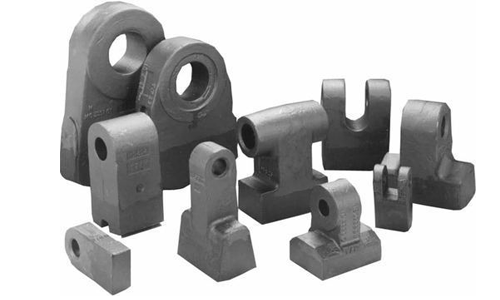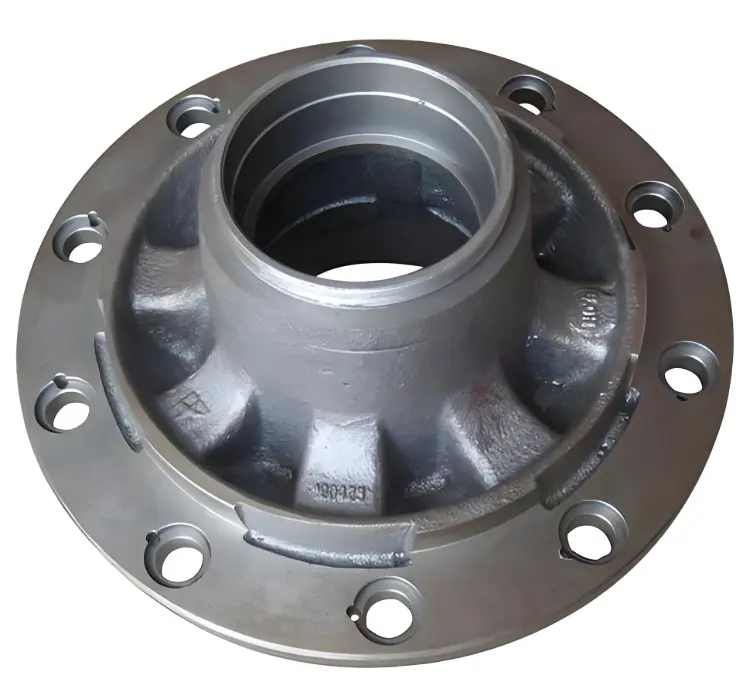The main reasons for shrinkage defects in high manganese steel castings are as follows:
Metal liquid solidification characteristics
Paste solidification: High manganese steel has a wide crystallization temperature range, and it solidifies in a paste-like manner during the solidification process. The liquid metal shrinkage channel is easily blocked early, resulting in the inability to effectively replenish the liquid metal, thus forming shrinkage holes.
Large volume shrinkage: High manganese steel will undergo a large volume shrinkage during the solidification process. If the liquid metal is not replenished in time or insufficiently, shrinkage holes will be formed inside the casting.
Gating system design of manganese steel castings
Improper riser setting: The number, size, and position of the risers are unreasonable, and sufficient liquid metal cannot be provided for shrinkage, which will cause shrinkage holes in the casting in the late solidification period.
Poor ingend design: The position and size of the ingend are not appropriate, which will make the flow state of the liquid metal entering the cavity unsatisfactory, causing local overheating or overcooling, affecting the shrinkage effect of the liquid metal, and then causing shrinkage holes.
Casting structure design of manganese steel castings
Complex structure: The casting structure is complex, such as the presence of thick and large parts connected to thin-walled parts, and there are more bosses or grooves, which will make the flow and shrinkage of liquid metal during the solidification process difficult, and shrinkage cavities are easily formed in these parts.
Uneven wall thickness: The difference in wall thickness of the casting is too large, the cooling speed of the thick wall is slow, and the liquid metal solidifies for a long time, requiring more liquid metal for shrinkage, while the liquid metal solidifies first at the thin wall, which will cut off the shrinkage channel at the thick wall, resulting in shrinkage cavities at the thick wall.
Melting and pouring process
Poor smelting quality: The gas content in the molten metal is too high, such as hydrogen, oxygen, etc., which will form pores during the solidification process, and will also affect the fluidity and shrinkage-filling ability of the liquid metal, increasing the possibility of shrinkage formation.
Too high pouring temperature: Too high pouring temperature will increase the liquid shrinkage of the liquid metal, and will also prolong the solidification time, increase the air intake of the liquid metal, reduce the fluidity and shrinkage-filling ability of the liquid metal, and easily lead to the formation of shrinkage cavities.
Improper pouring speed: If the pouring speed is too fast, the liquid metal will generate turbulence in the mold cavity, entrain gas, and affect the shrinkage compensation effect of the liquid metal; if the pouring speed is too slow, the temperature of the liquid metal will drop too quickly during the pouring process, the fluidity will deteriorate, and it will not be conducive to shrinkage compensation, thus producing shrinkage cavities.
Casting process
Poor permeability of the mold: If the permeability of the mold is poor, the gas in the mold cavity cannot be discharged in time. During the solidification process of the casting, the space occupied by the gas will form pores, which will also hinder the shrinkage compensation of the liquid metal and cause shrinkage cavities.
Insufficient mold yield: If the mold cannot yield in time when the casting solidifies and shrinks, it will have a greater hindering effect on the casting, increase the internal stress of the casting, and make the casting prone to defects such as cracks and shrinkage cavities during the solidification process.
The preventive measures for shrinkage defects in high manganese steel castings are mainly the following:
Optimize the structural design of the casting
Uniform wall thickness: When designing castings, the wall thickness should be as uniform as possible to avoid excessive wall thickness differences. For thick and large parts, the wall thickness can be reduced by setting reinforcing ribs, etc., to ensure that the liquid metal can cool and shrink evenly during the solidification process, which is convenient for shrinkage compensation.
Simplify the structure: reduce the complexity of the casting, avoid too many bosses, grooves and corners, so that the liquid metal flows more smoothly in the cavity, which is conducive to shrinkage compensation and reduces the risk of shrinkage cavity formation.
Reasonable design of the pouring system
Riser design: According to the structure and solidification characteristics of the casting, the number, size and position of the riser should be reasonably determined. The riser should be set at the highest part of the casting and the last solidified part to provide sufficient liquid metal for shrinkage compensation.
Ingate design: optimize the position and size of the ingate so that the liquid metal can enter the cavity smoothly and evenly to avoid turbulence and splashing. The number of ingates should be reasonably determined according to the size and complexity of the casting to ensure that the liquid metal can quickly fill the cavity without causing local overheating.
Strictly control the smelting and pouring process
Smelting process: use high-quality raw materials and strictly control the chemical composition and impurity content during the smelting process. Use refining equipment to refine the molten metal, reduce the gas content, and improve the purity and quality of the molten metal.
Pouring process: Select a suitable pouring temperature. Generally speaking, the pouring temperature of high manganese steel should be controlled between 1400℃-1450℃. At the same time, the pouring speed should be controlled to avoid pouring too fast or too slow.
Improve the casting process
Improve the permeability of the casting: Select molding materials with good permeability. For example, in sand casting, coarse sand or an appropriate amount of permeable materials can be used to improve the permeability of the casting. Reasonably set the exhaust holes or exhaust channels so that the gas in the mold cavity can be discharged in time.
Enhance the yieldability of the casting: Use casting materials with good yieldability, such as adding an appropriate amount of organic binder or disintegrator to the sand mold to improve the yieldability of the casting. For some complex castings, combined castings or yieldable cores can be used to reduce the obstruction of the casting to the shrinkage of the casting.
Using advanced solidification control technology
Application of chiller: Reasonably place chillers at thick and large parts or hot spots of castings to speed up the cooling of these parts, so that the liquid metal can solidify directionally and realize sequential solidification from bottom to top, thereby improving the shrinkage compensation effect of liquid metal and reducing the generation of shrinkage cavities.





